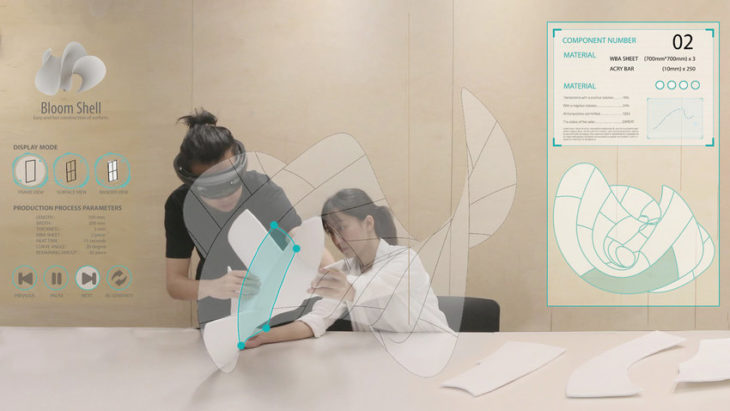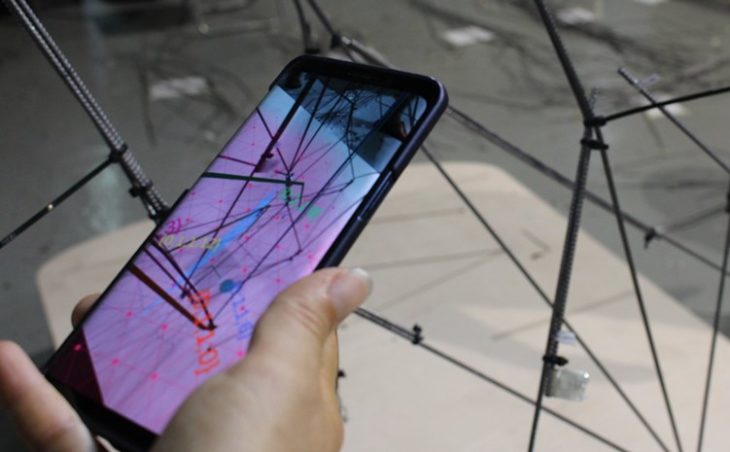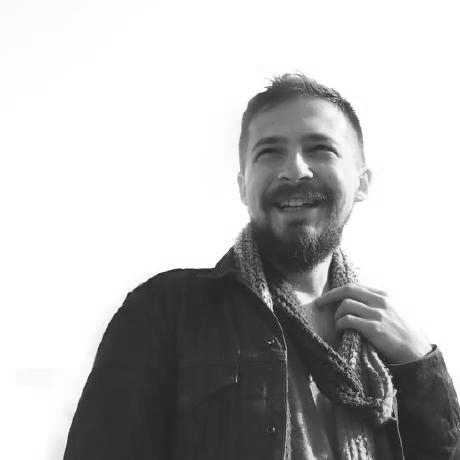Fab.AR
ASSISTED FABRICATION WITH AUGMENTED REALITY
Seminar Faculty: Daniil Koshelyuk, Nikol Kirova, Gabriele Jureviciute
Digital fabrication allows architects to achieve high precision and extreme variability of designs. Computational design tools further expand the ability to simulate natural processes, express complex geometries, interface with fabrication machines, and further involve the target audience in various stages of design. However, often behind the race for automation, certain cratsmanship qualities are being left behind. For one, certain material properties are inherently hard to express quantitatively. Moreover, as advanced architects a common challenge with algorithmic workflows is lack of aesthetical control and disconnection from the target user, whereby a definition acts as a black box.

Credits: BloomShell / Bartlett BPro Research Cluster 9 2017-18 / Directed by: Soomeen Hahm & Alvaro Lopez Rodriguez / Students: Yi Lin, Yushi Gao, Yang Song, Jiayi Liu
The advances in Mixed Reality (MR) technologies have opened up possibilities to overlap digital information ontop of physical spaces. Out of the full spectrum of MR technologies, Augmented Reality (AR) provides a vast range of applications on all stages of the creative process: from design, to idea communication, from visualisation, to assistance in fabrication or assembly. Democratisation of the technology made it extremely accessible leaving the realm of technological experiments into fully integrated real-world use cases. Thus, MR at its current state provides a unique opportunity to create custom interfaces and tools facilitating our expression. Indeed, architecture has been increasingly absorbing knowledge from related fields and architects and designers are pushed to consider even more facets for the projects, while keeping the core ideas reachable.
Within the seminar students are invited to explore the toolchain of Augmented Reality when applied to digital fabrication related scenarios, combining physical prototyping, material testing, computational design and augmented reality, in order to bridge the gap between the physical and digital realm and propose new ways for guided manual fabrication. Around this core objective, students will isolate a target stage of the design process they want to extend, develop custom tools for it and explore new possibilities for communication these tools can bring.

Credits: HoloFab / Ardeshir Talaei, Daniil Koshelyuk, Armin Akbari
Learning Objectives
At course completion the student will:
- Know how to work with Unity & Vuforia & MRTK;
- Know how to create prototype interfaces in augmented and mixed reality applications;
- Develop a workflow for assisted fabrication through the use of AR;
- Develop a case study applying it to a materials system and fabrication/assembly technique that is guided / assisted by AR;
- Expand the possibilities of manual fabrication process by overlaying them with digital models in AR
- Bridge the gap between the digital and physical worlds within the architectural applications.
Faculty

Daniil Koshelyuk is an architect from Moscow, Russia, holding Bachelors diploma of Architecture and Masters of Advanced Architecture (MAA02) from IAAC. Daniil has been working with interactive museum installations, merging physical computing and computational design tools; mixed reality projects for various applications, from product design to urban analysis; and teaching and assisting in a range of seminars in computational design, physical computing and mixed reality, as well as workshops, such as GSS Barcelona 18 and 19, Drafting Deception for MRAC 21.
In his career Daniil has been exploring situations where, in a broad sense of the words, physical and digital layers intersect. His interests centre around creating smarter, more responsive and interactive environments by digitally enhancing architecture, creating tools for unconventional interactivity, and managing and designing complex systems.
daniil.koshelyuk.site/
linkedin.com/in/dkfactotum

Nikol Kirova is an interdisciplinary Bulgarian architect with an educational background in interior design, urban planning, and advanced architecture. Currently, Nikol is a teaching assistant and a researcher at IAAC, developing her Ph.D. with a focus of her research is the integration of material innovation in design and architecture, as part of the IAAC-SWIN offshore Ph.D. program, developed with the Swinburne University of Technology.
The common feature of her work is the search for alternative solutions for optimised construction, material informed design, and spatial communication. Her research interest lies in investigating how materiality in architecture and construction can be reestablished and propose a better communication between the built environment and its inhabitants.
For a couple of years Nikol was developing Synapse, a smart material system for real-time urban flow data collection toward responsive environments and informed decision making. The novel research was awarded with the Digital Matter and Intelligent Construction and the Artificially and Materially Intelligent Architecture excellence awards in 2018 and 2019.
linkedin.com/in/nikol-kirova-2366915a/

Gabriele Jureviciute is a Lithuanian architect with a Master’s Degree in Advanced Architecture from the Institute for Advanced Architecture of Catalonia. She has currently taken a position in IAAC as the coordinator of the Master in Advanced Architecture (MAA01) and the faculty assistant of Advanced Manufacturing Thesis Cluster of the MAA02.
Gabriele’s professional interests include sustainable and responsive architecture, digital fabrication, and material circularity. Her master thesis project developed at IAAC has been based on the topic “Plastic Emergency Architecture: Creating low-cost, accessible architecture from waste material, improving liveability in areas affected by mismanaged plastic waste”. The project has been exhibited during the events such as Barcelona Building Construmat 2019 and Architects@Work Madrid 2019. Moreover, it has been developed further during the Residency program at Autodesk Build Space in Boston.
Before coming to IAAC Gabriele has been working as an architect in Lithuania and Portugal. Furthermore, she was involved in many events related to the European Architecture Students Assembly (EASA).
gabrielejureviciute.com/
linkedin.com/in/gabriele-jureviciute/